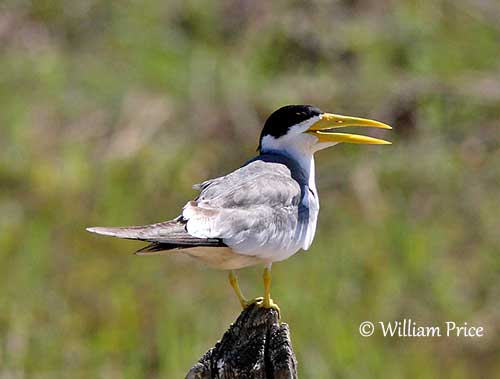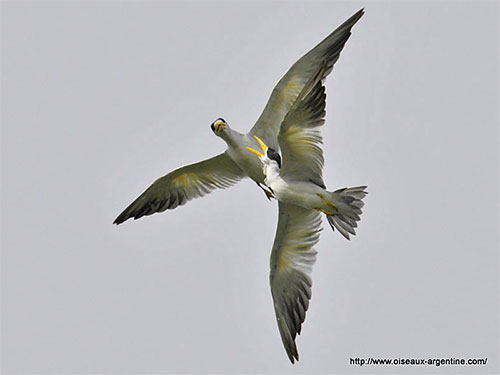
Fr: Sterne à gros bec
Ang: Large-billed Tern
All: Großschnabel-Seeschwalbe
Esp: Charrán Picudo
Ita: Sterna beccogrosso
Nd: Grootsnavelstern
Sd: sydamerikansk flodtärna
Photographers:
Roger Ahlman
Pbase Galleries Peru and Ecuador
John Anderson
John Anderson Photo Galleries
Jean-Claude Billonneau
Photographe-témoin de la Beauté du Monde
Didier Buysse
Vision d’Oiseaux
Alfredo Colón
Puerto Rico Wildlife
Jean Michel Fenerole
Photos d’Oiseaux du monde
Steve Garvie
RAINBIRDER Photo galleries & Flickr Rainbirder
Ken Havard
My Bird Gallery & Flickr gallery 1 & Flickr gallery 2
Jean-Claude Jamoulle
A la rencontre des Oiseaux
William Price
PBase-tereksandpiper & Flickr William Price
Philippe et Aline Wolfer
GALERIE
Text by Nicole Bouglouan
Sources:
HANDBOOK OF THE BIRDS OF THE WORLD Vol 3 by Josep del Hoyo-Andrew Elliott-Jordi Sargatal - Lynx Edicions - ISBN : 8487334202
BIRDS OF PERU by Thomas S. Schulenberg, Douglas F. Stotz, Daniel F. Lane, John P. O’Neill, Theodore A. Parker III – Princeton University Press 2007–ISBN: 978-0-691-13023-1
BIRDS OF VENEZUELA by Steven L. Hilty – Ed. Christopher Helm – ISBN: 0713664185
A GUIDE TO THE BIRDS OF COLOMBIA by Steven L. Hilty and William L. Brown - Princeton University Press – ISBN 069108372X
Neotropical Birds – Cornell Lab of Ornithology
South Dakota Birds and Birding – (Terry L. Sohl)
What Bird-The ultimate Bird Guide (Mitchell Waite)
The Online Guide to the Animals of Trinidad and Tobago
SORA - Occurrence of Large-billed Tern (Phaetusa simplex) in Ohio
Large-billed Tern
Phaetusa simplex
Charadriiformes Order – Laridae Family
INTRODUCTION:
The Large-billed Tern is a large tern with a disproportionally long, thick, pointed yellow bill. This bill allows the bird to catch fish of 4-12 centimetres long after hovering over water and plunging to seize the prey. This tern becomes sometimes aggressive and steals food from other birds.
The Large-billed Tern usually frequents both freshwater and saltwater habitats including lakes and rivers, estuaries, bays, sandbars, beaches and wetlands.
This species was first described in 1789 by Johann Friedrich Gmelin, a German naturalist, botanist and entomologist.
The Large-billed Tern is not globally threatened and the overall population is apparently stable. Two subspecies share the wide range in a large northern half of South America and some nearby islands.

DESCRIPTION OF THE BIRD:
Biometrics:
Length: 38-42 cm
Wingspan: 86-91 cm
Weight: 208-247 g
The Large-billed Tern has grey upperparts, usually darker than in most terns. On the upperwing, secondaries and greater coverts are white. In flight, the wing pattern is conspicuous with black primaries and triangular white patch on secondaries and wing coverts, reminiscent of Sabine’s Gull. The tail is grey, forked and relatively short.

Lores, lower cheeks, chin, throat and underparts are white, including underwing and undertail, but primaries and secondaries have black tips and sides of flanks are tinged grey.
On the head, the narrow white forehead contrasts with the black crown including the eyes and extending to the nape where it forms a vertical black band.
The yellow bill is long, thick and pointed. The eyes are blackish-brown. Legs and feet are greenish-yellow.
Male and female are similar.

The non-breeding adult has paler forehead and crown, with only a black patch from the rear eye to the nape.
The juvenile is paler overall and resembles non-breeding adults. It has less black on the head and wings and back are mottled brown. The bill is dull yellow.

SUBSPECIES AND RANGE:
The Large-billed Tern has two subspecies.
P.s. simplex occurs in E Colombia E to Trinidad and S through Amazonia. It was formerly present in E Ecuador.
P.s. chloropoda is found in the basins of R Paraguay and R Paraná, SW to NC Argentina (Santiago del Estero, rarely Córdoba).
This race has slightly paler upperparts and brighter yellow bill.

P.s. chloropoda
Argentina
HABITAT:
The Large-billed Tern can be found along coastlines, in bays, estuaries, sandbars and wetlands. It can be seen in broad and sometimes narrow inland rivers and lakes.
During the non-breeding season, it also frequents beaches and coastal mangroves. They feed in both freshwater and saltwater habitats.

CALLS AND SONGS: SOUNDS BY XENO-CANTO
The Large-billed Tern is a noisy bird. It gives “squeee-ee” calls and nasal, parrot-like “ink-onk”
The contact calls include a series of raspy “kew” and “kree” notes.

BEHAVIOUR IN THE WILD:
The Large-billed Tern feeds on freshwater and saltwater fish of 4-12 centimetres long. It also takes crustaceans and insects.
The aquatic prey are caught by flying over the water and plunging to snatch the fish with the bill.
Some observations indicate that this species hunts sometimes like the Black Skimmer by skimming the water surface for prey. Insects are caught after aerial chases.

The Large-billed Tern is often aggressive and may steal food from other birds. This species is usually seen alone or in pairs, but they may roost in small flocks. They can be seen in mixed-species flocks when feeding and nesting.

During the breeding season, this large tern becomes territorial and often returns to its previous nesting sites. They often breed in mixed-species flocks and can be seen alongside Black Skimmer, other tern species and Sand-coloured Nighthawk. Both parents share the nesting duties.

The Large-billed Tern is usually considered a permanent resident in most of the range. However, they disperse after the breeding season and can be found in a great variety of aquatic habitats, and especially along coastlines.
This species can be seen in the West Indies (accidental), Honduras, Costa-Rica, Panama, and USA (Illinois, Ohio and New Jersey). It is only a visitor to Trinidad. It is also recorded in W of the Andes in NW Peru and in SW Ecuador.
But these sightings remain occasional and rare.

The flight of the Large-billed Tern is direct with strong, shallow wingbeats.


REPRODUCTION OF THIS SPECIES:
The breeding season varies depending on the range. It occurs in May-June and October-December in N of the range, and August-September in Argentina.
The Large-billed Tern may nest singly or in mixed-species groups. It is territorial and monogamous. The nesting period is closely associated with water levels.
The nest is a shallow scrape in the sand of sandbars and beaches, and in Amazon flood plains.

The female lays 1-3 pale grey to olive-brown eggs with brown markings. Both adults incubate during 27-30 days. After hatching, the chicks usually leave the nest within a day, and both parents feed them. They are able to fly between 55 and 65 days after hatching. The adults defend the young by mobbing predators and all potential threats.
This species produces a single brood per year.

PROTECTION / THREATS / STATUS:
The Large-billed Tern is widespread throughout its range in South America. Like numerous birds, it is threatened by habitat changes, flooding and predation during the nesting period.
The population of the nominate race is placed in the band 10,000/25,000 individuals, but the race “chloropoda” is more numerous. These populations are apparently stable.
The Large-billed Tern is currently evaluated as Least Concern.


P.s. chloropoda
Argentina